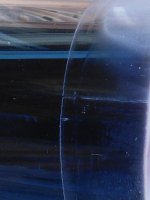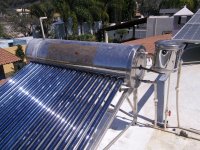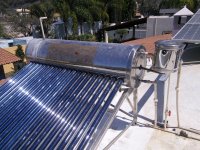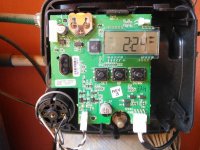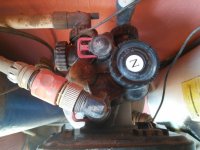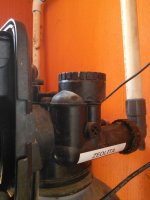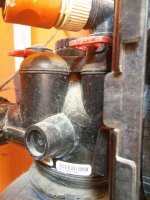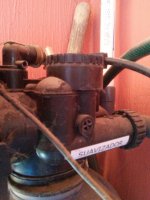Some history, the issues, and my current understanding.
My wife and I live in Chapala, Mexico, about 40 miles south of Guadalajara, great climate, and weather year round, at an altitude of around 5,000 feet, not much humidity.
We are on a community well, and, it is my belief, there is no processing of or for the water.
Three years ago, we purchased a 3 bedroom, 3 bath house, and replaced the old, outdated, unmaintained water softener, with a locally sourced unit, unkown brand name, but uses clack valves. This did reduce the scale build up, the water feels good when showering.Two years ago, I had a solar water heater installed, previously we used propane for heating of domestic water, about two weeks ago, I noticed water running from the roof drain, inspection revels the glass tubes seals were leaking, I hired a guy to fix, mistake, he used silicone sealant, in an attempt to fix the issue, they leaked worse after. I elected to repair myself, using new seals, and several glass tubes were replaced, yes, I broke some.
During the process of cleaning the silicone from the ends of the tubes, I noticed, and what I initially thought, was scale build up, but my later thinking is glass erosion, and scratching. I'll include a couple pics, one of the overall system, and one of the tube in question.
In order to determine if the glass had scale build up, or scratching/scoring, I soaked the area in CLR, overnight, and attempted to remove, no such luck, next I tried muriatic acid, a cotton swab was dipped into the acid, applied to the area, and left for a period of time, again no such luck at material removal. A knife edge will hang, upon encountering the scratch, erosion area. My determination is erosion, and scratching, caused by high mineral content, developed from the concentrated water solution, within the heating tank.
Now for some numbers.
TDS readings:
Before entering the house 275 ppm = 16 grains hard, the math: ppm/17.1
SOFTENED WATER FOLLOWS
Faucet #1 kitchen 261 ppm 15 gr first filter 20 sediment ,second filter 5 carbon, UV light
Faucet #2 kitchen 261 ppm 15 gr first filter 20 micron, and second 5 carbon, UV light, I know, this needs to be rethought.
solar water heater 422 ppm 24.5 gr
Bottled water, we purchase from a local company, and it is RO, and several other filtering processes completed 23 ppm 1.3 gr
NOTE: The solar water and domestic water are separate, there is a copper coil within the heater reservoir, that contains and heats the domestic water.
I am not a fan of the color matching tests, but thats all I have found to date. But heres what they show, 2 different types.
Total Hard = very low
PH = Very High
Total alkalinity = Very High
second one:
zero cloro
alk = 180
ph = 7.2
TH = 100
cya = 40
The above is at the kitchen faucet #1
Ok, my guessing begins as to the tube erosion, scratching.
The water entering the heat chamber, is regulated via a float valve, and there is no pressure within the heat chamber, and it operates via the principle of cold water is heavier than hot, and circulation is accomplished, because there is very little water movement surrounding the area of the silicone seal, more or less stagnate, some water will be trapped under and between the seal and glass, because there is little water exchange within the tank res, just evaporation or leakage, and it operates at an elevated temperature, the minerals in the water are concentrated, as observed with the elevated TDS readings.
The glass tubes are supposed to be borosilicate glass, for transmission of light and corrosion resistance. I have no method to determine, this type of glass is laboratory grade, similar to pyrex glassware, this from internet readings. There seem to be suggestions of those readings, that under lab conditions, corrosion does occur, under "elevated" temps, and similar ph values, but don't say what an elevated temp is.
I have the water softener guy coming by, tomorrow, but would like to be informed, as to the valve mechanism. I have no idea as to where the part number is located, whether or not, if this valve is adjustable for grain hardness, or is this an electronic, non-adjustable valve.
Here's the pics.
Thanks for the help.
My wife and I live in Chapala, Mexico, about 40 miles south of Guadalajara, great climate, and weather year round, at an altitude of around 5,000 feet, not much humidity.
We are on a community well, and, it is my belief, there is no processing of or for the water.
Three years ago, we purchased a 3 bedroom, 3 bath house, and replaced the old, outdated, unmaintained water softener, with a locally sourced unit, unkown brand name, but uses clack valves. This did reduce the scale build up, the water feels good when showering.Two years ago, I had a solar water heater installed, previously we used propane for heating of domestic water, about two weeks ago, I noticed water running from the roof drain, inspection revels the glass tubes seals were leaking, I hired a guy to fix, mistake, he used silicone sealant, in an attempt to fix the issue, they leaked worse after. I elected to repair myself, using new seals, and several glass tubes were replaced, yes, I broke some.
During the process of cleaning the silicone from the ends of the tubes, I noticed, and what I initially thought, was scale build up, but my later thinking is glass erosion, and scratching. I'll include a couple pics, one of the overall system, and one of the tube in question.
In order to determine if the glass had scale build up, or scratching/scoring, I soaked the area in CLR, overnight, and attempted to remove, no such luck, next I tried muriatic acid, a cotton swab was dipped into the acid, applied to the area, and left for a period of time, again no such luck at material removal. A knife edge will hang, upon encountering the scratch, erosion area. My determination is erosion, and scratching, caused by high mineral content, developed from the concentrated water solution, within the heating tank.
Now for some numbers.
TDS readings:
Before entering the house 275 ppm = 16 grains hard, the math: ppm/17.1
SOFTENED WATER FOLLOWS
Faucet #1 kitchen 261 ppm 15 gr first filter 20 sediment ,second filter 5 carbon, UV light
Faucet #2 kitchen 261 ppm 15 gr first filter 20 micron, and second 5 carbon, UV light, I know, this needs to be rethought.
solar water heater 422 ppm 24.5 gr
Bottled water, we purchase from a local company, and it is RO, and several other filtering processes completed 23 ppm 1.3 gr
NOTE: The solar water and domestic water are separate, there is a copper coil within the heater reservoir, that contains and heats the domestic water.
I am not a fan of the color matching tests, but thats all I have found to date. But heres what they show, 2 different types.
Total Hard = very low
PH = Very High
Total alkalinity = Very High
second one:
zero cloro
alk = 180
ph = 7.2
TH = 100
cya = 40
The above is at the kitchen faucet #1
Ok, my guessing begins as to the tube erosion, scratching.
The water entering the heat chamber, is regulated via a float valve, and there is no pressure within the heat chamber, and it operates via the principle of cold water is heavier than hot, and circulation is accomplished, because there is very little water movement surrounding the area of the silicone seal, more or less stagnate, some water will be trapped under and between the seal and glass, because there is little water exchange within the tank res, just evaporation or leakage, and it operates at an elevated temperature, the minerals in the water are concentrated, as observed with the elevated TDS readings.
The glass tubes are supposed to be borosilicate glass, for transmission of light and corrosion resistance. I have no method to determine, this type of glass is laboratory grade, similar to pyrex glassware, this from internet readings. There seem to be suggestions of those readings, that under lab conditions, corrosion does occur, under "elevated" temps, and similar ph values, but don't say what an elevated temp is.
I have the water softener guy coming by, tomorrow, but would like to be informed, as to the valve mechanism. I have no idea as to where the part number is located, whether or not, if this valve is adjustable for grain hardness, or is this an electronic, non-adjustable valve.
Here's the pics.
Thanks for the help.

